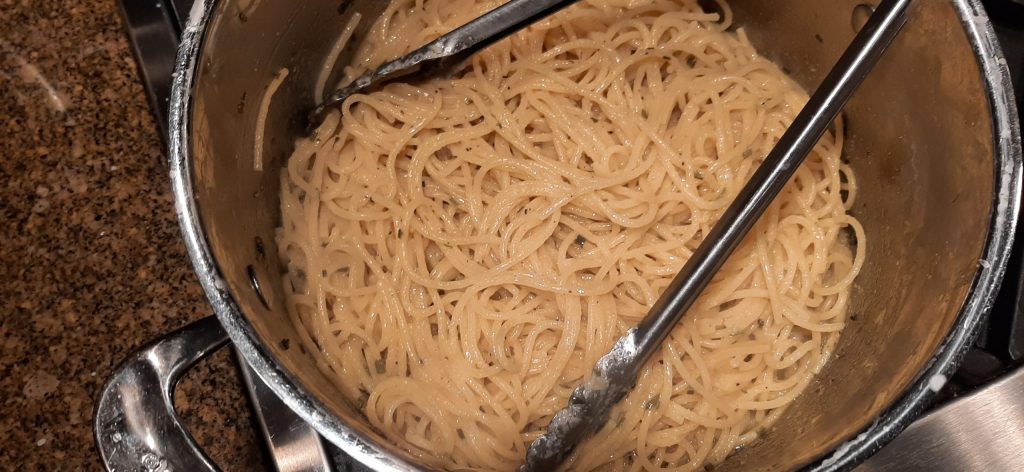
So, this is not a low-fat, low calorie pasta recipe. This is an in-your-face, decadent, and indulgent way to appreciate one of the greatest culinary gifts ever presented to mankind. Pasta.
What you perhaps don’t know about me, is that I am a devoted fan of all things pasta. And although I mainly try to keep my recipes as low-fat and low-calorie as reasonable, this is not one of them. This is the brain child of our dear friend Jim. Who BTW is a wonderful cook and could probably make the rusted bumper of a 1954 chevy taste good. Not kidding!
The other evening, Mr. C. and I had the opportunity to help out in Jim and Margo’s kitchen for an impromptu dinner where all 4 of us (Jim, Margo, Mr. C., and I) were assigned drink and food preparation tasks. (BTW, this was a fun way to get dinner on the table.)
Under Jim’s direction, I was put in charge of the pasta. And I must say, I was a bit aghast at the ingredient list. Wait! That’s a lot of butter and olive oil you’re telling me to throw in the al dente pasta. And 2 tablespoons of granulated garlic? Holy cow!
But being the good little minion that I am, I followed his instructions to a tee. And the result? Amazing pasta. Not only did I love the pasta with sauce on it, but I went back for seconds for just the pasta alone. It was just that delicious.
Now of course, it helped that the pasta used for this dish was made in Italy. Italian pasta typically has strict governmental quality and control standards. And it is made with 100% durum wheat (semolina flour), a hard grain. Hard grain contains much more fiber, more protein and also carotenoids (recognized by the fact that it is more yellow than other grains). Durum wheat also retains more starch during cooking which is essential for producing excellent al dente pasta. If the pasta releases starch too easily, it quickly becomes a sticky mess. So, pasta made in Italy is not only higher in protein, but it stands up better to submersion in boiling water.
So, whenever possible, bring home pasta made in Italy. And never, ever cook pasta more than al dente. According to Barilla, “Cooking pasta perfectly ‘al dente’ (still slightly firm) allows you to reap the full benefits of pasta’s already strong ability to increase satiety, delaying hunger pangs and providing fuel for working muscles long after meals.” “Plus, al dente pasta just plain tastes better.” (That quote is attributed to Patti Carr!) And as written up in the health section of U.S. News, “Prepare your pasta like they do in the Mediterranean – al dente, which means neither too hard nor too soft. When cooked correctly, pasta will have a lower glycemic index than when it’s cooked to be soft or mushy. The average GI of al dente penne pasta is 50, which is even lower than the GI of oatmeal or many whole-grain breakfast cereals. A lower GI can help keep blood sugar levels stable so you will stay fuller longer.”
Well, I’ve said all I’m going to say about pasta and this recipe. If you can’t conclude for yourself that pasta prepared this way is a treat, then I won’t bother you any further with additional information.
And as always, thank you Jim and Margo for your friendship and love, and for all the wonderful food we have shared together throughout the many years we have known each other. May there be many more good times to come.
And as always, peace and love to all.
1 lb. spaghetti (preferably made in Italy with 100% durum wheat semolina – organic Garofalo brand from Costco is fabulous)
2 T. kosher or coarse sea salt
¼ c. (½ stick) unsalted butter
¼ c. extra virgin olive oil
1-2 T. granulated garlic (I used a scant 2 tablespoons last evening)
2 T. freeze dried chives
1 c. pasta cooking water, or more as needed (I used about a cup and a half)
freshly ground black pepper, if desired
Bring a pot of water to a boil. Not too much water. Add the salt and pasta. Cook the spaghetti at a low boil, stirring periodically with a pair of tongs, until almost to the al dente stage. (Err on the side of not enough cooking time rather than too much.)
Drain the pasta, keeping at least 2 cups of pasta water in reserve.
Add the drained spaghetti back to the pot. Turn the burner on low and stir in the butter, olive oil, granulated garlic, and dried chives. Cook until the butter is melted. Then add a cup of the pasta water and cook until most of the water is gone. Taste the pasta. It should now be at a perfect al dente. If you prefer a moister pasta, add more pasta cooking water, a couple of tablespoons at a time.
Please note: No additional salt should be required because of the amount of salted water in which the pasta was cooked. If you are a black pepper fan, go ahead and add as much as you like.
This pasta can be served as a stand-alone side dish (passing grated Greek mizithra, pecorino-Romano, or Parmigiano-Reggiano at table), or with inclusions such as thinly sliced prosciutto or petite green peas, or as a base for any of your favorite pasta sauces.
Leftovers can be stored in either the refrigerator or for longer storage, your freezer. If your pasta has been frozen, bring to room temp. before re-heating.
To re-heat your cooked pasta, coat the bottom of a frypan with water. Add the pasta and periodically give it a stir. Leave on heat only until the pasta is hot. Serve any way you wish.
